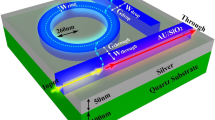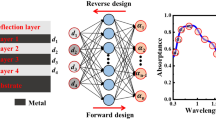Abstract
An analytical and numerical study of hybrid photonic–plasmonic crystals is presented. The proposed theoretical model describes a system composed of a dielectric photonic crystal on a metallic thin film. To show the validity and usefulness of the model, four particular structures are analyzed: a one-dimensional crystal and three lattices of two-dimensional crystals. The model can calculate the photonic band structure of photonic–plasmonic crystals as a function of structural characteristics, showing two partial bandgaps for a square lattice, and complete bandgaps for triangular lattices. Furthermore, using a particular high-symmetry path, a full bandgap emerges in rectangular lattices, even with a small refractive index contrast. Using the analytical model, a dataset is generated to train an artificial neural network to predict the center and width of the bandgap, that is, the forward design. In addition, an artificial neural network is trained to tune the optical response, that is, to perform the inverse design. The analytical results are consistent with the physics of the system studied and are supported by numerical simulations. Moreover, the prediction accuracy of the artificial neural networks is better than 95%. Overall, this paper reports a useful tool for tuning the optical properties of hybrid photonic–plasmonic crystals with potential applications in waveguides, nanocavities, mirrors, etc.






































Similar content being viewed by others
Data Availability
The datasets generated during and/or analyzed during the current study are available from the corresponding authors on reasonable request.
Code Availability
The codes used during the current study are available from the corresponding authors on reasonable request.
References
Igor A (2009) Sukhoivanov and Igor V. Springer, Guryev. Photonic crystals
Sakoda K (2005) Optical Properties of Photonic Crystals. Springer
Joannopoulos JD, Johnson SG, Winn JN, Meade RD (2008) Photonic crystals: molding the flow of light. Princeton University Press, Princeton, New Jersey
Maier SA (2007) Plasmonics: Fundamentals and Applications. Springer
Kitson SC, Barnes WL, Sambles JR (1996) Full photonic band gap for surface modes in the visible. Phys Rev Lett 77:2670–2673
Bozhevolnyi SI, Erland J, Leosson K, Skovgaard PMW, Jørn M (2001) Hvam. Waveguiding in surface plasmon polariton band gap structures. Phys Rev Lett 86:3008–3011
Bozhevolnyi SI, Volkov VS, Leosson K, Boltasseva A (2001) Bend loss in surface plasmon polariton band-gap structures. Appl Phys Lett 79(8):1076–1078
Bozhevolnyi SI, Volkov VS (2001) Multiple-scattering dipole approach to modeling of surface plasmon polariton band gap structures. Opt Commun 198(4):241–245
Drezet A, Koller D, Hohenau A, Leitner A, Aussenegg FR, Krenn JR (2007) Plasmonic crystal demultiplexer and multiports. Nano Lett 7(6):1697–1700. PMID: 17500579
Volkov VS, Bozhevolnyi SI, Leosson K, Boltasseva A (2003) Experimental studies of surface plasmon polariton band gap effect. J Microsc 210(3):324–329
Baudrion A-L, Weeber J-C, Dereux A, Lecamp G, Lalanne P, Bozhevolnyi SI (2006) Influence of the filling factor on the spectral properties of plasmonic crystals. Phys Rev B 74:125406
Randhawa S, González MU, Renger J, Enoch S, Quidant R (2010) Design and properties of dielectric surface plasmon bragg mirrors. Opt Express 18(14):14496–14510
Liu TL, Russell KJ, Cui S, Hu EL (2014) Two-dimensional hybrid photonic/plasmonic crystal cavities. Opt Express 22(7):8219–8225
Joseph S, Joseph J (2019) Photonic-plasmonic hybrid 2d-pillar cavity for mode confinement with subwavelength volume. IEEE Photonics Technol Lett 31(17):1433–1436
Søndergaard T, Bozhevolnyi SI (2003) Vectorial model for multiple scattering by surface nanoparticles via surface polariton-to-polariton interactions. Phys Rev B 67:165405
Søndergaard T, Bozhevolnyi SI (2005) Theoretical analysis of finite-size surface plasmon polariton band-gap structures. Phys Rev B 71:125429
Kretschmann M (2003) Phase diagrams of surface plasmon polaritonic crystals. Phys Rev B 68:125419
Feng L, Ming-Hui L, Lomakin V, Fainman Y (2008) Plasmonic photonic crystal with a complete band gap for surface plasmon polariton waves. Appl Phys Lett 93(23):231105
Mohammed F, Quandt A (2016) A simple perturbative tool to calculate plasmonic photonic bandstructures. Opt Mater 56:107–109. Advanced Materials for Optics. Photonics, Renewable Energies and Their Recent Advances
Ma W, Liu Z, Kudyshev ZA, Boltasseva A, Cai W, Liu Y (2021) Deep learning for the design of photonic structures. Nat Photonics 15(2):77–90
Liu D, Tan Y, Khoram E, Zongfu Y (2018) Training deep neural networks for the inverse design of nanophotonic structures. ACS Photonics 5(4):1365–1369
Johnson PB, Christy RW (1972) Optical constants of the noble metals. Phys Rev B 6:4370–4379
Peters G, Wilkinson JH (1970) ax = λbx and the generalized eigenproblem. SIAM J Numer Anal 7(4):479–492
Ruhe A (1973) Algorithms for the nonlinear eigenvalue problem. SIAM J Numer Anal 10(4):674–689
Zhang X, Qiu J, Li X, Zhao J, Liu L (2020) Complex refractive indices measurements of polymers in visible and near-infrared bands. Appl Opt 59(8):2337–2344
Pedregosa F, Varoquaux G, Gramfort A, Michel V, Thirion B, Grisel O, Blondel M, Prettenhofer P, Weiss R, Dubourg V, Vanderplas J, Passos A, Cournapeau D, Brucher M, Perrot M, Duchesnay É (2011) Scikit-learn: Machine learning in python. J Mach Learn Res 12(85):2825–2830
Funding
Jorge-Alberto Peralta-Ángeles acknowledges CONACYT support with a PhD fellowship. This work was supported by DGAPA-UNAM IN112919.
Author information
Authors and Affiliations
Contributions
Theoretical ideas were developed by both authors. The algorithms and simulations were developed by Jorge-Alberto Peralta-Ángeles; both authors contributed to the discussion and preparation of the manuscript.
Corresponding authors
Ethics declarations
Ethics Approval
Not applicable.
Consent to Participate
Not applicable.
Consent for Publication
Both authors consent to publication.
Conflict of Interests
The authors declare no competing interests.
Additional information
Publisher’s Note
Springer Nature remains neutral with regard to jurisdictional claims in published maps and institutional affiliations.
Rights and permissions
About this article
Cite this article
Peralta-Ángeles, JA., Reyes-Esqueda, JA. Analytically Supported Hybrid Photonic–plasmonic Crystal Design Using Artificial Neural Networks. Plasmonics 17, 1501–1525 (2022). https://doi.org/10.1007/s11468-022-01640-9
Received:
Accepted:
Published:
Issue Date:
DOI: https://doi.org/10.1007/s11468-022-01640-9




